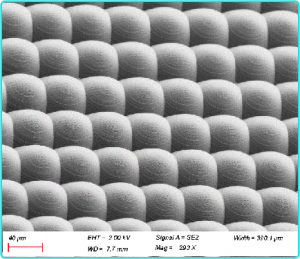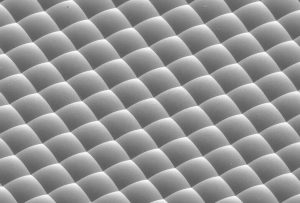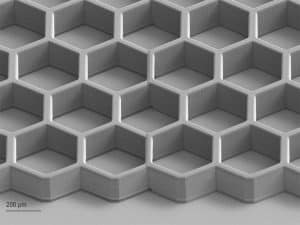
Micro and Nano Processing | AIE Polymer Light Emitting Device Fabrication
Micro and nano light-emitting devices play an important role in the development of integrated optics, such as: optical gain materials in organic lasers and electronic display field of great application prospects; light-emitting materials that respond to pressure or chemical substances can be used as sensors; in addition, microstructure arrays prepared with different light-emitting materials, through reasonable light regulation in the field of anti-counterfeiting also shows good application value.
In real applications, solid-state devices (e.g., thin films, functional structures) have a much wider range of applications than some substances in liquid or free state, which requires some luminescent materials to still have good luminescence efficiency when in solid or aggregated state. Therefore, it is important to find efficient solid-state luminescent materials and apply them in polymer devices.
Among the various types of luminescent materials, aggregation-induced luminescent materials, as a new class of luminescent materials, have attracted extensive attention and research due to their unique luminescent properties.AIE materials are highly efficient in solid-state luminescence, and the resulting composite resin was successfully used to prepare polymeric micro and nano luminescent structures. Polymer light-emitting devices are an important class of functional photonic devices, in which light-emitting materials are doped or modified into polymers to make complexes, which are then flexibly prepared into various solid-state photonic devices by self-assembly and sophisticated processing techniques. These light-emitting devices have excellent applications in many fields such as lasers, optical communication, sensing, illumination and display, printing, biological diagnosis, anti-counterfeiting, etc.
The better compatibility of polymeric materials allows doping and processing of multiple functional materials. For example, Sun et al. doped the laser dye rhodamine B (RhB) into SU-8 photoresist and then used femtosecond laser direct writing techniques to prepare a variety of miniature resonant cavity structures and achieve low-threshold laser output. Yang et al. at Tsinghua University have carried out a series of sensing-related work around carbon dot-doped polymers (e.g., hydrogels), using waveguide structures to achieve sensing and detection of a variety of substances. It is clear that the application direction of polymeric light-emitting devices depends mainly on the specific properties of the light-emitting materials and the functionality of the structured photonic devices. To broaden the scope of application of polymer light-emitting devices and to improve the efficiency of the devices, it is necessary to continuously improve the properties of light-emitting materials and to find suitable processing methods to make functional devices that meet the application directions.
Polymer light-emitting devices in which light-emitting materials (e.g., organics small molecules, rare-earth upconversion materials, quantum dots, etc.) are mixed in a polymer matrix by doping or modification, etc., to emit light under suitable light or electrical excitation. In practice, taking into account factors such as energy consumption and device lifetime, the constant pursuit of more efficient light-emitting devices, that is, in the lowest possible light or electricity excitation, the device to achieve the target luminous intensity. For solid-state devices, the luminous intensity is mainly related to the luminous efficiency of the luminous component itself and the doping ratio. Conventional light-emitting materials have enhanced intermolecular forces at high concentrations or in the solid state, and the strong π-π stacking effect causes the dye molecules to undergo fluorescence bursts, which greatly limits the value of organic light-emitting dyes in solid-state light-emitting devices. According to the previously reported work on RhB polymer microlaser, the optimal doping ratio of the gain material RhB in polymer is 1 wt%. Further increase of the doping concentration will not only cause a sharp fluorescence burst, but also the RhB molecules will appear in clusters in the polymer which will affect the device morphology and performance.
As a new class of organic luminescent materials, the unique mechanism of luminescence restricted by intra-molecular motion has fundamentally overcome the problem of aggregation burst of dye molecules and achieved high efficiency luminescence in solid state, which has undoubtedly injected a fresh blood into the development of solid-state luminescent devices.
Processing technology for polymer micro-optics devices:
1. Mask lithography
Structured processing of photosensitive polymer materials by means of mask exposure.
2. Laser and electron beam direct writing technology
Direct writing is a maskless lithography technique that produces structural information by controlling the coordinate position of the focused spot on the photographic coating.
3. Nanoimprinting technology
Nanoimprinting is a process for replicating structured patterns on micro and nano, which can be used to accomplish high-precision and large-area preparation of micro and nano structures.
We offer fastMEMS device / micro and nanostructure processing design services, Feel free to leave a message to inquire.
Related Products
Related Reading
Micro and Nano Processing | Process Overview
Micro and Nano Processing | Thin Film Deposition, Photolithography, Etching Overview Nanofabrication Division
LIGA Plating | Machining metal microstructures, inertial sensing/RF/heat sink parts
LIGA/UV-LIGA Plating | Metal Microstructure RF
Micro and Nano Processing | MEMS Fine Processing (IV)
Micro and Nano Processing | MEMS Fine Processing (IV) 1.3 Photolithography


